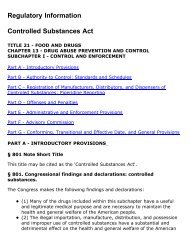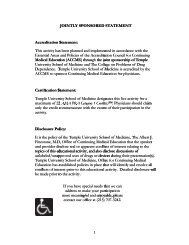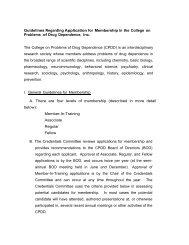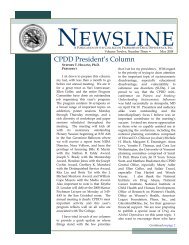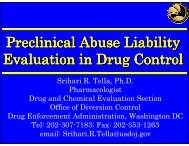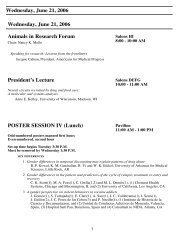CPDD 72nd Annual Meeting • Scottsdale, Arizona - The College on ...
CPDD 72nd Annual Meeting • Scottsdale, Arizona - The College on ...
CPDD 72nd Annual Meeting • Scottsdale, Arizona - The College on ...
Create successful ePaper yourself
Turn your PDF publications into a flip-book with our unique Google optimized e-Paper software.
21<br />
WHERE THE RUBBER MEETS THE ROAD: AN<br />
INTEGRATED MODEL OF TECHNOLOGY TRANSFER IN<br />
THE INNOVATION PROCESS.<br />
A ATTC Network Technology Transfer Workgroup; ATTC Network, Kansas<br />
City, MO<br />
Aims: Over a decade ago the Institute of Medicine (IOM) issued a seminal<br />
report focusing <strong>on</strong> substance abuse treatment that specifically acknowledged disseminati<strong>on</strong><br />
of research findings into practice as an area in critical need of<br />
improvement and of great importance to the quality of treatment. A key recommendati<strong>on</strong><br />
was increased collaborati<strong>on</strong> between federal agencies, educati<strong>on</strong>al and<br />
research instituti<strong>on</strong>s, and community-based treatment facilities to reduce barriers<br />
to the integrati<strong>on</strong> of research, treatment, and policy. While impressive Federal<br />
initiatives followed, the field c<strong>on</strong>tinues to lack integrated theories and models of<br />
technology transfer to inform and standardize how innovati<strong>on</strong>s (research findings,<br />
evidence-based practices) are communicated and transferred to the field.<br />
Methods: Through a process of reviewing literature, theory, and 15 years of the<br />
ATTC Network’s experience, the ATTC Network Technology Transfer<br />
Workgroup developed a c<strong>on</strong>ceptual model representing the role of technology<br />
transfer within the innovati<strong>on</strong> process.<br />
Results: We will present the model al<strong>on</strong>g with definiti<strong>on</strong>s for seven key terms:<br />
development, disseminati<strong>on</strong>, implementati<strong>on</strong>, translati<strong>on</strong>, adopti<strong>on</strong>, technology<br />
transfer, and diffusi<strong>on</strong>.<br />
C<strong>on</strong>clusi<strong>on</strong>s: <str<strong>on</strong>g>The</str<strong>on</strong>g> lack of a c<strong>on</strong>ceptual model and an integrated tax<strong>on</strong>omy related<br />
to the innovati<strong>on</strong> process has created c<strong>on</strong>fusi<strong>on</strong> and limited the ability of<br />
researchers and the public to understand basic principles of technology transfer<br />
useful in facilitating the movement of research findings to practice. For example,<br />
a pitfall of implementing new treatments is attempting to use a new practice following<br />
a brief training. <str<strong>on</strong>g>The</str<strong>on</strong>g>n when the treatment does not work as expected, it<br />
is discarded. <str<strong>on</strong>g>The</str<strong>on</strong>g> ATTC Network c<strong>on</strong>ceptual model and definiti<strong>on</strong>s can be used<br />
by the addicti<strong>on</strong> treatment and recovery services field to more easily understand<br />
the process of innovati<strong>on</strong>, and how technology transfer can speed the use of evidence-based<br />
treatments to enhance and improve client outcomes.<br />
Financial Support: This work was supported by SAMHSA/CSAT grants to the<br />
ATTC Nati<strong>on</strong>al Office and Regi<strong>on</strong>al Centers.<br />
23<br />
ASSOCIATION STUDY BETWEEN THE OPRM1<br />
POLYMORPHISM 17C>T AND HEROIN OR COCAINE<br />
ADDICTION IN AFRICAN AMERICANS.<br />
Olaoluwakitan Awolesi 1 , S Ham<strong>on</strong> 1 , E Ducat 1 , M Randesi 1 , J Rotrosen 2 , P<br />
Casad<strong>on</strong>te 2 , S Linzy 3 , M Adels<strong>on</strong> 3,1 , M J Kreek 1 , O Levran 1 ; 1 <str<strong>on</strong>g>The</str<strong>on</strong>g> Laboratory of<br />
the Biology of Addictive Diseases, Rockefeller University, New York, NY, 2 VA<br />
New York Harbor Healthcare System and NYU School of Medicine, New York,<br />
NY, 3 Dr. Miriam and Sheld<strong>on</strong> G. Adels<strong>on</strong> Clinic for Drug Abuse, Treatment,<br />
and Research, Las Vegas, NV<br />
Aims: <str<strong>on</strong>g>The</str<strong>on</strong>g> n<strong>on</strong>syn<strong>on</strong>ymous SNP 17C>T (Ala6Val), located at the N-terminus<br />
of the mu-opioid receptor gene (OPRM1) in close proximity to the 118A>G,<br />
occurs in relatively high frequency in African populati<strong>on</strong>s and very low frequency<br />
in Asian and European populati<strong>on</strong>s. Several groups reported higher frequency<br />
of the variant “T” allele in populati<strong>on</strong>s with substance dependence but the<br />
reports have not been c<strong>on</strong>sistent.<br />
This study aims to explore associati<strong>on</strong> between 17C>T and heroin or cocaine<br />
addicti<strong>on</strong> in African Americans.<br />
Methods: A total of 614 African American subjects (58% males) were analyzed<br />
including: a) former severe heroin addicts treated at methad<strong>on</strong>e maintenance<br />
treatment programs (n=220), b) cocaine dependent subjects who met DSM-IV<br />
criteria for cocaine dependence (n=224), and c) c<strong>on</strong>trol subjects with no history<br />
of alcohol abuse or illicit drug use (n=170). All subjects were recruited in NYC<br />
and Las Vegas. <str<strong>on</strong>g>The</str<strong>on</strong>g> 17C>T SNP was genotyped using TaqMan® technology and<br />
verified by sequencing.<br />
Results: Observed genotype distributi<strong>on</strong>s were c<strong>on</strong>sistent with Hardy-Weinberg<br />
equilibrium (p=0.39). <str<strong>on</strong>g>The</str<strong>on</strong>g> minor allele frequency (the “T” allele) was 0.22, 0.25,<br />
and 0.26 (heroin, cocaine, and c<strong>on</strong>trols, respectively). No significant difference<br />
in allele or genotype frequency was found between heroin or cocaine addicts and<br />
c<strong>on</strong>trols (p>0.14). No significant difference was found when the analyses were<br />
stratified by sex (p>0.2).<br />
C<strong>on</strong>clusi<strong>on</strong>s: <str<strong>on</strong>g>The</str<strong>on</strong>g> 17C>T SNP is not associated with heroin or cocaine addicti<strong>on</strong><br />
in African Americans.<br />
Financial Support: This study was supported by NIDA-P60-05130 (M.J.K.)<br />
<str<strong>on</strong>g>CPDD</str<strong>on</strong>g> <str<strong>on</strong>g>72nd</str<strong>on</strong>g> <str<strong>on</strong>g>Annual</str<strong>on</strong>g> <str<strong>on</strong>g>Meeting</str<strong>on</strong>g> <str<strong>on</strong>g>•</str<strong>on</strong>g> <str<strong>on</strong>g>Scottsdale</str<strong>on</strong>g>, <str<strong>on</strong>g>Ariz<strong>on</strong>a</str<strong>on</strong>g><br />
6<br />
22<br />
A 2 YEAR FOLLOW-UP STUDY TO ASSESS EXPERIMENTAL<br />
THERAPEUTIC COMMUNITIES IN FRANCE. AN<br />
ONGOING STUDY.<br />
Marc Auriacombe 1 , C Denis 1 , E Langlois 2 , M Fatséas 1 , A Vérétout 2 , C Diaz-<br />
Gomez 3 ; 1 Addicti<strong>on</strong> Psychiatry EA4139/INSERM-IFR99, Universite Victor<br />
Segalen Bordeaux 2, Bordeaux, France, 2 Sociology LAPSAC, Universite Victor<br />
Segalen Bordeaux 2, Bordeaux, France, 3 OFDT, OFDT, Paris, France<br />
Aims: While <str<strong>on</strong>g>The</str<strong>on</strong>g>rapeutic Communities (TCs) are generally c<strong>on</strong>sidered to be an<br />
effective method, the bulk of the research evidence is from poorly c<strong>on</strong>trolled<br />
studies. On French authorities’ initiative, experimental TCs have been allowed to<br />
open since 2007. This was associated to a research program.<br />
<str<strong>on</strong>g>The</str<strong>on</strong>g> objective of this presentati<strong>on</strong> were (1) to present objective and methods of<br />
this research program and (2) to present comparis<strong>on</strong> of TC residents with outpatient<br />
setting subjects. Chi2 or Fisher tests were used to compare qualitative<br />
data and Student or ANOVA for quantitative tests.<br />
Methods: Residents are assessed at entry and at 6-, 12-, 18- and 24-m<strong>on</strong>th after<br />
intake regardless of compliance in TCs. Several questi<strong>on</strong>naires are used to collect<br />
data (ASI, MINI, CAI, CMRS, CAS, SAS) and combined qualitative interviews<br />
of both residents and staff following sociological methods.<br />
Results: 1 : Objective of the research program: (1) To describe the c<strong>on</strong>struct of<br />
TCs, (2) To define the clients’ expectati<strong>on</strong>s for TCs vs other treatment for addicti<strong>on</strong>,<br />
(3) To assess the impact at 2-year after entry into TCs, (4) To determine the<br />
associated factor with effectiveness, (5) To compare the evoluti<strong>on</strong> of clients entering<br />
TCs versus clients in outpatient program for addicti<strong>on</strong> at 2-year after entry<br />
into treatment.<br />
2 : 67 residents were assessed. In comparis<strong>on</strong> with clients in outpatient settings,<br />
they were older and had received more previous treatments for medical, psychiatric<br />
and addicti<strong>on</strong>-related disorders. <str<strong>on</strong>g>The</str<strong>on</strong>g>y reported to use the same type of<br />
drugs but started their use younger and were more often polydrug users. <str<strong>on</strong>g>The</str<strong>on</strong>g>y<br />
showed higher level of impairment and presented more prevalent psychiatric<br />
comorbidities.<br />
C<strong>on</strong>clusi<strong>on</strong>s: By combining a quantitative method and a qualitative method<br />
using sociological interviews we expect to better address the issue of TC effectiveness<br />
in the French c<strong>on</strong>text.<br />
Financial Support: French M<strong>on</strong>itoring Center (OFDT) and French Health<br />
Ministry.<br />
24<br />
PROGESTERONE MODULATION OF THE DISCRIMINATIVE<br />
STIMULUS EFFECTS OF TRIAZOLAM.<br />
Shanna Babal<strong>on</strong>is, J A Lile, C A Martin, T H Kelly; University of Kentucky,<br />
Lexingt<strong>on</strong>, KY<br />
Aims: Sedative drugs effects am<strong>on</strong>g women may be enhanced during the luteal<br />
phase of the menstrual cycle and with progester<strong>on</strong>e pre-treatment, although<br />
some inc<strong>on</strong>sistencies have been reported. This study builds <strong>on</strong> previous research<br />
by examining whether sensitivity to the discriminative stimulus effects of triazolam<br />
are modulated by progester<strong>on</strong>e pre-treatment.<br />
Methods: This study examined the discriminative stimulus effects of triazolam,<br />
al<strong>on</strong>e and in combinati<strong>on</strong> with progester<strong>on</strong>e, in healthy, premenopausal women<br />
(n=9). After triazolam discriminati<strong>on</strong> was established (training dose: .25 mg/70<br />
kg triazolam), test doses (0, .06, .12, and .25) of triazolam were administered<br />
al<strong>on</strong>e and in combinati<strong>on</strong> with oral progester<strong>on</strong>e (100 mg). Participants completed<br />
cardiovascular measures, verbal reports of drug effect, and computer tasks<br />
designed to assess psychomotor and impulsive behavior. Drug effects were analyzed<br />
using repeated measures ANOVA with triazolam dose, progester<strong>on</strong>e dose<br />
and time as factors.<br />
Results: Triazolam functi<strong>on</strong>ed as a discriminative stimulus in healthy women<br />
and engendered prototypical sedative-like effects <strong>on</strong> subjective measures of drug<br />
effect. Progester<strong>on</strong>e al<strong>on</strong>e substituted for triazolam in a small number of participants<br />
(n=2) and produced sedative-like behavioral effects, while no substituti<strong>on</strong><br />
occurred in the other participants (n=7). On average, progester<strong>on</strong>e pre-treatment<br />
had no effect <strong>on</strong> the discriminative stimulus of triazolam, although progester<strong>on</strong>e<br />
both increased (leftward shift of the dose resp<strong>on</strong>se curve) and decreased<br />
(rightward shift) triazolam sensitivity across participants and dose c<strong>on</strong>diti<strong>on</strong>s.<br />
C<strong>on</strong>clusi<strong>on</strong>s: Inc<strong>on</strong>sistencies in the literature relating menstrual cycle and progester<strong>on</strong>e<br />
modulati<strong>on</strong> of sedative drug effects may reflect these individual differences<br />
and future research is required to identify factors associated with these individual<br />
differences.<br />
Financial Support: DA-024127, RR-15592.





![2013SYMP AND WORKSHOP LIST[web]](https://img.yumpu.com/35325424/1/190x245/2013symp-and-workshop-listweb.jpg?quality=85)
